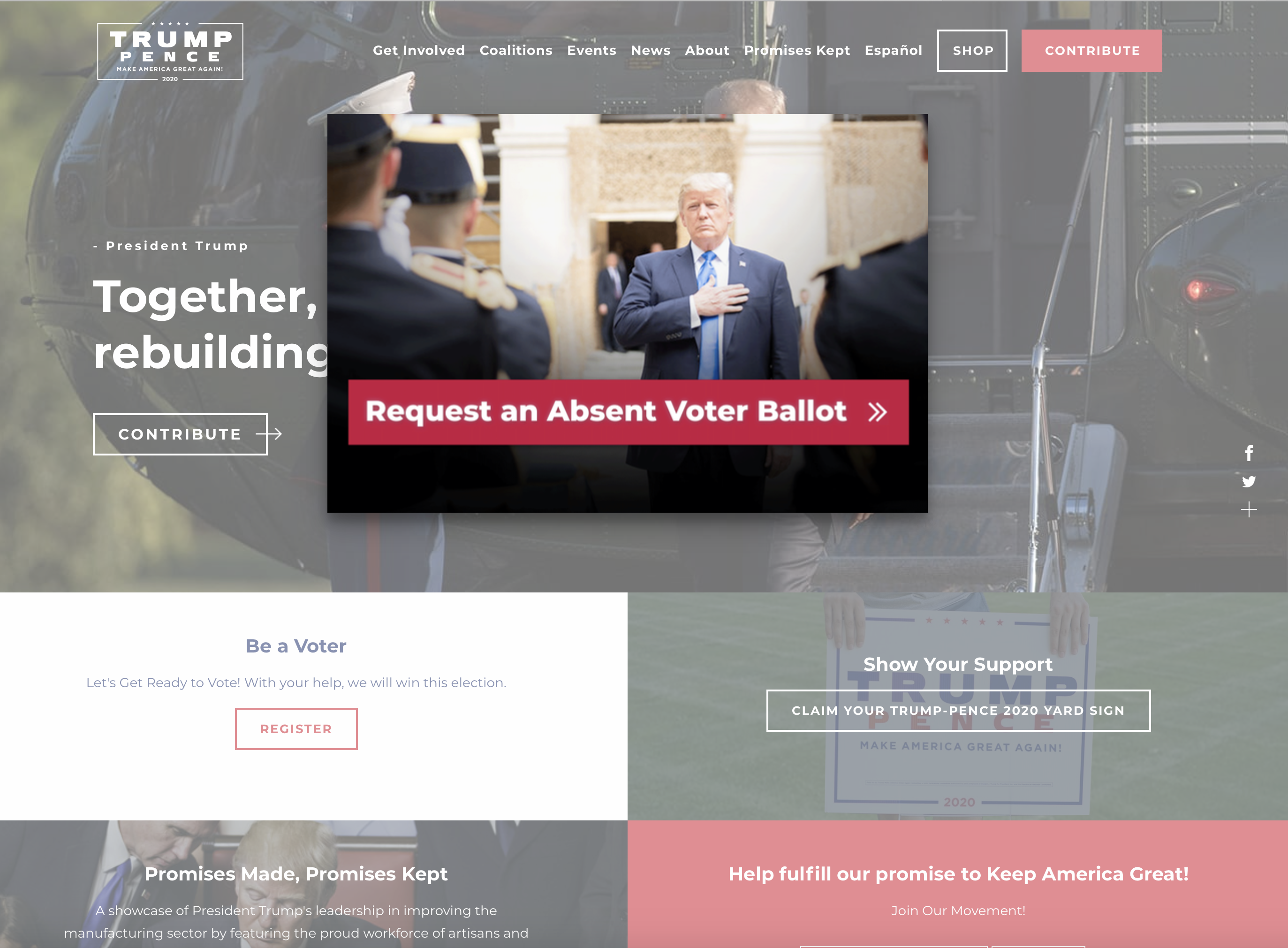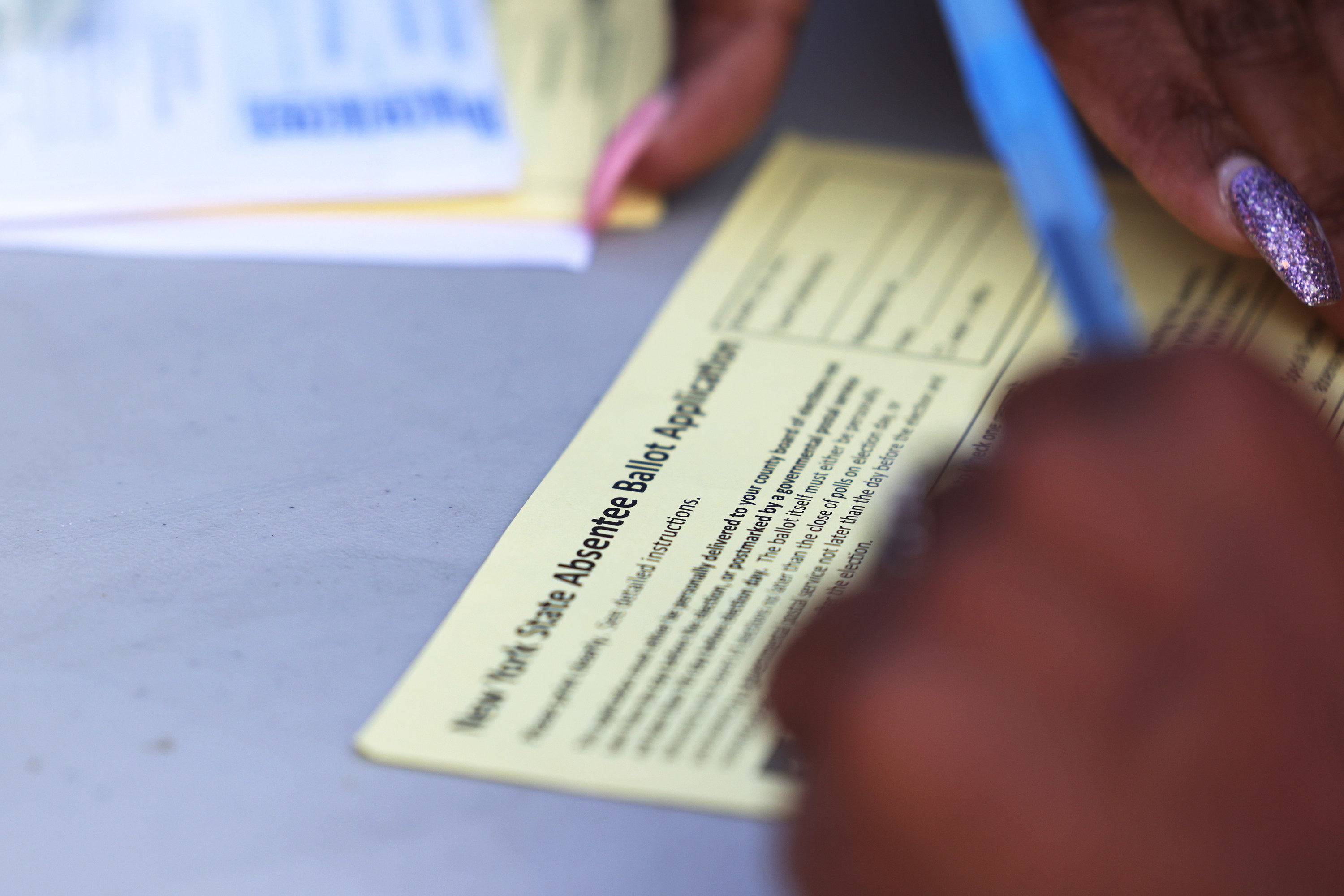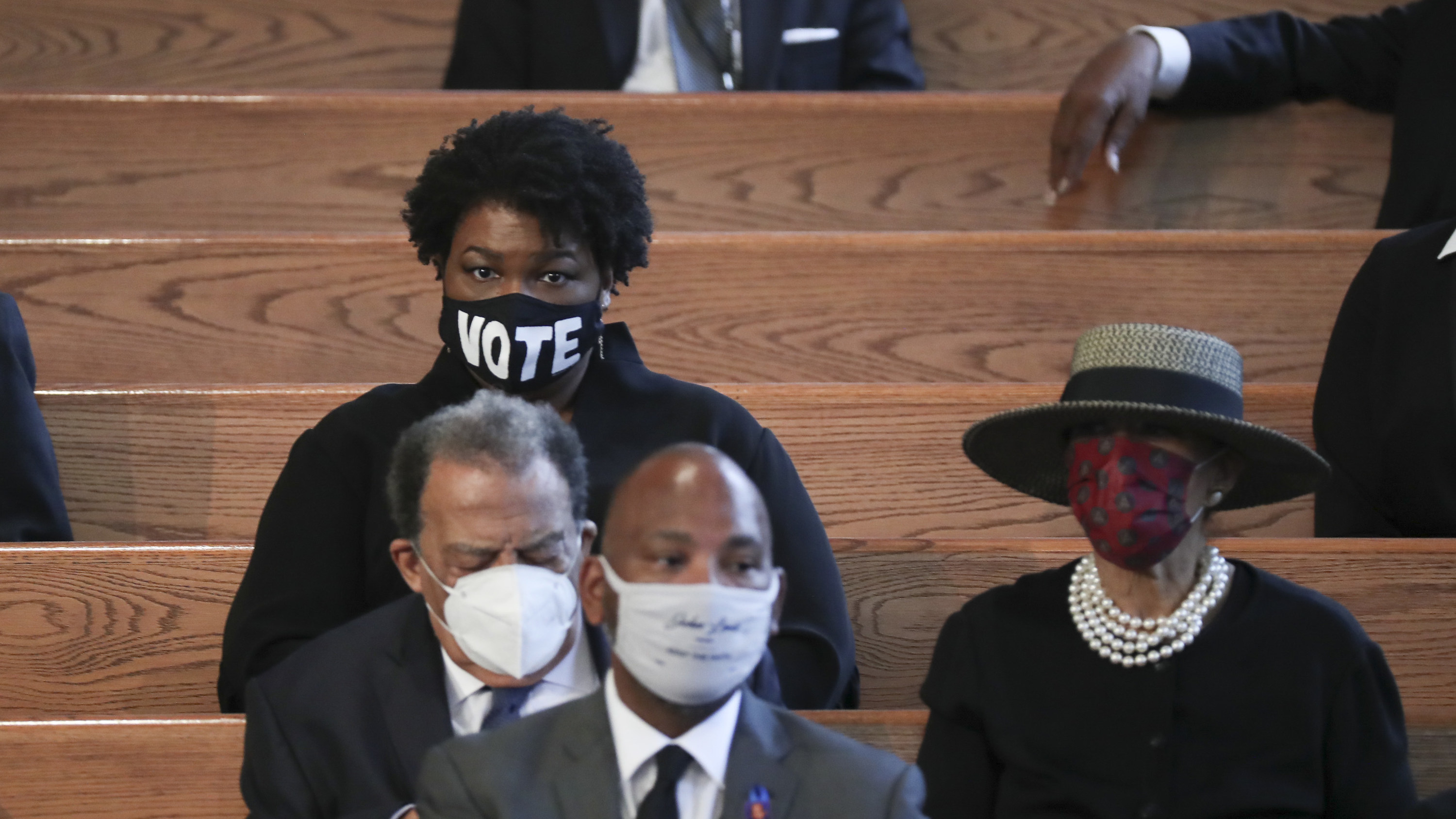
For nearly four years, President Donald Trump has waged a war on facts, encouraging people to doubt science, distrust journalism, and disbelieve the very things they’ve heard or seen. And in the past six months, he's run a heightened campaign of confusion on a critical target: voting.
Trump, his administration, his campaign apparatus, and the Republican Party are deliberately undermining trust in the most fundamental democratic activity, marking a dangerous new turn in the GOP’s long-standing efforts to limit the franchise.
The effort to undercut trust in voting isn’t just about Election Day itself. On Wednesday, Trump again suggested he might attempt to stay in office should he lose in November, blaming time-tested voting methods for potentially preventing a peaceful transfer of power.
“Get rid of the ballots and you'll have a very peaceful — there won’t be a transfer, frankly. There’ll be a continuation.”
Some in the Republican Party have worked to limit voting for decades, laying down the foundation for Trump to engage in overt voter suppression tactics unseen since the civil rights era. Racial disenfranchisement, which has long been a part of Black Americans’ experience with voting, has advanced across the country as states and advocacy groups continue to battle over purging voter rolls, stringent voter ID laws, decreasing the number of polling places, and limiting the right to vote for formerly incarcerated people.
But in 2020, Trump and his allies have honed in on mail-in ballots and the Postal Service as people across the country seek ways to vote without contracting a deadly disease or spreading it to their loved ones. Mail-in ballots increase people’s access to the polls, and Republicans know that greater access to voting in some areas or communities could potentially benefit Democrats.
And so Trump, through a pattern of confusing, contradictory, incomplete, and exaggerated statements, is making it extremely difficult to determine what information is real and what is bullshit. In some cases, he is making voting seem dangerous or illegal. The goal is to sow doubt about the election’s security, stability, and ultimately, its result.
Voting by Mail
It sort of started, as many things do with Trump, on Fox & Friends. Just more than two weeks after he banned travel from Europe to the US because of the coronavirus, Trump was on his favorite right-wing talk show discussing his concerns about increased voting access in the 2020 election, echoing some Republicans’ claims that it would be the downfall of the GOP.
“The things they had in there were crazy,” he said about the Democrats’ coronavirus stimulus package, which would have mandated specific early voting timelines for all states and expand access to voting by mail. “They had levels of voting that if you ever agreed to it, you'd never have a Republican elected in this country again.”
“They had levels of voting that if you ever agreed to it, you'd never have a Republican elected in this country again.”
Widespread opposition among Republican lawmakers against expanded voting access followed.
Just days later in Wisconsin, as the state was expected to hit its first COVID-19 peak, the Republican-led legislature decided against delaying the April primary. The state Supreme Court later struck down an executive order from Democratic Gov. Tony Evers to postpone in-person voting, and the US Supreme Court ruled in favor of Wisconsin Republican lawmakers against extending the deadline for absentee ballots. As a result, thousands of residents wearing masks waited in line for hours to vote — the photos ricocheted around the country. Weeks later, more than 50 people who had worked at the polls or went out to vote reported testing positive for the coronavirus.
Four months later, Texas leaders sued Harris County, the largest county in its state, to stop officials from sending all registered voters absentee ballots. The state Supreme Court has since temporarily blocked the county from doing so, and the case remains up in the air.
Both the Trump campaign and Republican National Committee have backed these state-level efforts. Earlier this month, BuzzFeed News identified at least 11 cases where the Trump campaign has asked to intervene to defend these state and local policies that activists say will curb access to voting safely during a pandemic, on top of more than half a dozen lawsuits that the campaign and the Republican National Committee have filed to prevent the expansion of mail-in voting.
Trump has zeroed in on mail-in voting specifically, making feverish claims that a common method of casting a ballot will lead to voter fraud. At a press briefing in April, he called mail-in voting “horrible” and “corrupt.” But when asked by a reporter about his vote by mail in the Florida presidential preference primary the month before, Trump said he did that “because I’m allowed to.” (Vice President Mike Pence and a number of senior White House aides have also relied on vote-by-mail in the past.)
Since then, he has built a case against universal mail-in voting — which he alternately calls “100% mail-in voting” and a system of “unsolicited ballots” — based on conspiracy theories, fear, and unproven claims: Mail drop boxes are “not Covid sanitized” and will be robbed; mail-in ballots will be forged, illegally printed thousands of times, and fraudulently signed; literally anyone and everyone, alive or dead, will receive a ballot; and people will be able to cast multiple votes. Only nine states and the District of Columbia currently have universal mail-in voting, where election officials proactively mail ballots to all eligible voters rather than only to those who request them. Mail-in voting has strict procedures to ensure each ballot’s veracity. There was barely any truth to Trump’s claims, but the tweets to his 86 million followers came as a barrage.
“Absentee Ballots are a great way to vote for the many senior citizens, military, and others who can’t get to the polls on Election Day,” he tweeted on Apr. 8. “These ballots are very different from 100% Mail-In Voting, which is ‘RIPE for FRAUD,’ and shouldn’t be allowed!” (Crucially, voting by mail and absentee voting — different states prefer different terms — are essentially the same thing: systems that deliver ballots to voters.)
“The United States cannot have all Mail In Ballots. It will be the greatest Rigged Election in history,” he said in a May 24 tweet. “Some absentee OK, when necessary.” (Again, absentee and mail-in ballots are basically the same thing. And Trump’s own election integrity commission found in January 2018 that there was no evidence of widespread fraud.)
“With Universal Mail-In Voting (not Absentee Voting, which is good), 2020 will be the most INACCURATE & FRAUDULENT Election in history,” he tweeted on July 30. “Delay the Election until people can properly, securely and safely vote???” (See above.)
“The big Unsolicited Ballot States should give it up NOW, before it is too late, and ask people to go to the Polling Booths and, like always before, VOTE. Otherwise, MAYHEM!!! Solicited Ballots (absentee) are OK,” he tweeted on Sept. 17. (Five states with universal mail-in voting had established that as their primary voting method long before the pandemic; there has not been mayhem in their elections. Trump himself and his appointees have undermined the Postal Service’s ability to deliver these ballots.)
The Trump campaign's deputy national press secretary Thea McDonald said that the president "correctly distinguished" between universal mail-in ballots and absentee ballots, a distinction that Democrats and mainstream media "purposely ignore to sow confusion."
"Everyone, including the mainstream media, Democrats, and Republicans, wants to trust the election results on November 3," McDonald told BuzzFeed News. "We are fighting to make sure that’s the case, and any argument otherwise is a conspiracy theory intended to muddy the waters and disenfranchise voters even further."
But then, in August, Trump appeared to throw out his own made-up distinction of mail-in voting and absentee voting in a tweet directed at his supporters in Florida, a critical battleground state.
“Whether you call it Vote by Mail or Absentee Voting, in Florida the election system is Safe and Secure, Tried and True. ... so in Florida I encourage all to request a Ballot & Vote by Mail!” he tweeted.
Trump’s crusade has put Republicans in a “difficult position,” Richard Hasen, a University of California, Irvine professor and the author of Election Meltdown: Dirty Tricks, Distrust, and the Threat to American Democracy, told BuzzFeed News.
Mail-in ballots have actually helped Republicans win in key states like Florida, Hasen said. “It’s caused him and Republicans to try to draw somewhat nonsensical distinctions between absentee ballot and vote-by-mail.”
To add to the confusion, Trump’s campaign sent out material to voters encouraging them to apply for an absentee ballot. And in September, he urged supporters in Minnesota, New Hampshire, and Michigan to get an absentee ballot, calling them “safe and secure.”

And then, at two separate events in North Carolina in early September, Trump encouraged the very sort of voter fraud that he was also railing against. He said people should try to vote twice (which is a federal crime), first by absentee ballot and then in person on Election Day, framing it as a way to test the security of the election process. He also repeated this on Facebook and Twitter.
A White House spokesperson told BuzzFeed News that Trump was not advocating for people to break the law, but to make sure they verify that their vote is counted.
Because Trump often floods people with an onslaught of contradictory messages, it’s hard to know where exactly he stands on voting by mail. Either Trump believes that mass fraud can be committed more easily by mail-in voting — which there is no evidence for — or the president himself is misinformed, which is also unlikely since he appears to believe in the value of the absentee ballots that he has repeatedly cast.
“So the only conclusion I can draw is that this is a cynical effort to discourage voting on the part of one’s opposition,” said Vincent Hutchings, a research professor at the University of Michigan’s Center for Political Studies, “not because one has a good faith belief, however accurate [or not] that may be, that there’s something fraudulent about mail-in voting.”
The Post Office
As voting by mail emerged as a more appealing option for people who did not want to risk going to the polls, the US Postal Service, which has long delivered ballots to voters with no major issues, found itself suddenly a Trump target.
With Trump donor Louis DeJoy newly positioned as postmaster general in May, the USPS began enacting severe cost-cutting measures and removing mailboxes in certain cities, a move that drew widespread criticism.
Trump also began escalating his attacks on the Postal Service, saying it was enriching Amazon while becoming “dumber and poorer.” He also initially opposed including $25 billion in emergency funding for the Postal Service in a coronavirus relief bill.
The reason? Trump didn’t want to fund the USPS so that it wouldn’t be able to handle an increased load of mail-in ballots. In other words, the US president wanted to use the power of his office to prevent people’s votes from counting — and he admitted it. “They need that money in order to have the post office work so it can take all of these millions and millions of ballots,” Trump said on Fox Business. “If they don’t get those two items, that means you can’t have universal mail-in voting because they’re not equipped to have it.”
NAACP President Derrick Johnson told BuzzFeed News in August that the Trump administration’s interference with the Postal Service was “the most blatant attempt to suppress voters in modern history at least since the voter suppression tactics of the 1960s.”
On Sept. 17, a federal judge temporarily blocked all operational changes that DeJoy had ordered, saying he and the president were “involved in a politically motivated attack on the efficiency of the Postal Service” that could impact the election. DeJoy’s cost-cutting measures were also reversed. Days later, another federal judge ordered the Postal Service to prioritize election mail.
Still, the Postal Service’s delays with mail delivery in the past few months — particularly in places regarded as key swing states — have sparked concern over its ability to handle an influx of mail-in ballots. State election officials have said that the USPS has not provided proper guidance or communication to help them prepare for the surge of ballots.

The USPS has also bungled its own efforts to inform voters about voting by mail in the 2020 election. In September, the Postal Service mailed postcards to households across the country advising them to “request their mail-in ballot” early. In a state like Colorado, however, where every voter receives a ballot by mail without having to request one — Colorado is one of the five states that had universal mail-in voting pre-pandemic — that guidance created confusion.
“When we asked @USPS not to send the postcard with misinformation to voters in Colorado they flat out refused,” Colorado Secretary of State Jena Griswold tweeted. “Confusing voters about mail ballots in the middle of a pandemic is unacceptable.”
Griswold has since filed a lawsuit against the USPS, alleging that the agency sent out “false statements that will confuse Colorado voters.”
Recent Voter Suppression
Trump and his party’s tactics are having an effect. A September report from the Pew Research Center found that many voters have concerns about voting during the pandemic and are doubtful of the US Postal Service’s ability to deliver ballots on time.
Democrats were more likely than Republicans to expect difficulties when it came to casting their ballot and in the integrity of the 2020 election, but altogether roughly half of US voters in an August poll said they were expecting to have difficulties voting. That result is drastically different from the midterm elections of 2018, when 85% of voters said it would be easy to vote compared to the 15% who said they thought it would be difficult.
The Republican National Committee immediately responded to a request for comment. White House deputy press secretary Sarah Matthews told BuzzFeed News that there is “ample evidence that ballots cast by mail are more prone to contestation, less likely to be counted, and have a higher probability of being compromised than those cast in a voting booth.”
But election experts dispute the claim that voter fraud — which is extremely rare — will be widespread because of increased mail-in ballots, a claim that Trump and his party have repeatedly asserted. "We have not seen, historically, any kind of coordinated national voter fraud effort in a major election, whether it's by mail or otherwise," FBI Director Christopher Wray told Congress on Thursday.
“Enthusiasm amongst our voters to turnout for President Trump and Republicans up and down the ballot is incredibly high. Some are going to vote absentee through the proper process as they always do – and you will see us encouraging them to do that – but many of our voters just prefer to vote in person," RNC National Press Secretary Mandi Merritt told BuzzFeed News.
"There is a major distinction between a proper, typical absentee ballot process and what the Democrats are fighting for, which would bring chaos to our election," she said, for which there is no factual basis. "Our superior get-out-the-vote operation will work to ensure those who want to vote through the proper process are able to do so, while our legal team is fighting to protect against Democrat attempts to damage the integrity of the process.”
The pattern of the past few months has served to further disenfranchise communities of color during a time when many are already disproportionately impacted by a deadly virus.
In the last decade, 25 states have enacted laws that strengthened voting restrictions and made it harder for citizens to vote, particularly since the Supreme Court in 2013 struck down parts of Section 4 of the Voting Rights Act, which provided a formula for determining which states would need to have any changes to voting reviewed and approved by the Justice Department following their discriminatory practices around access to voting. The newer laws have made it especially harder for marginalized communities to vote.
“Because our party system in the US, the distribution of support of the two major parties cleaves so heavily along racial and ethnic lines,” Hutchings said, that “if one wants to benefit one party at the expense of another, doing so is efficient by focusing on people based on their race and ethnicity.”
“You can’t look at someone and see what their partisanship is, but you can look at them and see their race,” Hutchings said. “And if race correlates with party, then, well, it’s completely logical — if perhaps offensive and reprehensible but certainly rational — for people to target racialized populations in order to gain partisan advantage.”
That racial line is far more pronounced in states like Florida, where formerly incarcerated people who were convicted of felonies recently regained the right to vote after an overwhelming vote from state residents. According to a 2016 study from the Sentencing Project, nearly 1.7 million people, or 10.4% of the state’s population — 21.6% of Black Floridians — were disenfranchised by the state’s laws before the recent change.
Soon after the measure won at the ballot box, the Republican-controlled state legislature passed a law that requires former felons to pay off any court-related debts before their right to vote would be restored. A federal appeals court with multiple Trump-appointed judges upheld it.
Georgia is another example. A myriad of those issues were on display during Georgia’s gubernatorial election in 2018, when the Democratic nominee, Stacey Abrams, ran against Brian Kemp — who was serving as Georgia’s secretary of state and was in charge of the state’s elections.

In the month ahead of the election, Kemp’s office held 53,000 Georgians’ voter registration applications on a “pending” list because the state’s rules required the name listed on their application to accurately match their government ID. An AP analysis found that 70% of people on that list were Black. Kemp’s office also performed regular “voter roll maintenance,” which regularly removed people who hadn’t voted in the past seven years. Between 2012 and 2018, 1.4 million voter registrations in Georgia had been canceled.
Abrams’ and Kemp’s campaigns were virtually tied on Election Day. Kemp declared victory when it seemed like he had surpassed the threshold to win the election. Abrams initially refused to concede, citing complaints from voters about their mail-in ballots and provisional ballot not being counted by Election Day. After a dayslong legal fight, Abrams effectively ended her campaign and launched an organizing group, Fair Fight, to protect voting rights around the country. She added she would be filing a lawsuit against the state of Georgia “for gross mismanagement” of the election.
Advocates at Fair Fight said Abrams’ race in Georgia was a mirror of many of the same issues voters are now facing: with voting by mail gaining popularity, issues emerging with the USPS, and in-person polling places experiencing a shortage of resources and longer wait times during the pandemic.
“The problems that Georgia saw in November 2018 were present, if not even more so, in June 2020. You had voters who requested mail-in ballots but never received one, you had 20 counties needing to extend voting hours, you had a secretary of state sending wrong instructions to voters,” a spokesperson for Fair Fight told BuzzFeed News.
“Voters need a team of folks advocating for them on the ground, answering their questions, sending them helpful information, and holding elections officials accountable.”
The Presidential Election
Trump has taken aim at the country’s election system before — during the race he won, in 2016.
In the lead-up to Election Day, trailing in most polls, Trump declared the election “rigged” in favor of Hillary Clinton.
And after taking office, Trump claimed — with no evidence — that millions of people had voted illegally. That, baselessly explained, was the reason he didn’t win the popular vote.
In May 2017, he issued an executive order forming an election integrity commission to investigate voter fraud. By January 2018, the commission had been disbanded after it couldn’t find evidence it was happening on a widespread basis — the Justice Department charged only 19 foreigners with illegally voting during the 2016 election.
The shift in 2020 isn’t that Trump is undermining an entire election. It’s that he’s doing it in a very specific way: questioning the very act of casting a ballot, using the power of his office to help hinder how those ballots are delivered, and targeting people who have traditionally been disenfranchised.
And it may end up weakening trust in the political system as a whole. “Both on behalf of his supporters who believe that the system is rigged to help Democrats, and on behalf of his opponents who believe that Trump is doing this to make it harder for people to vote by mail in the middle of a pandemic and trying to rig the election in his favor,” Hasen said.
“It’s a double whammy,” Hasen added. “It lowers the confidence of people on both sides on the fairness of the election.”
Hutchings said it very well may work.
“It could [have an impact] in the margins,” he said, “and of course if the election is determined at the margins, then it could be consequential.”

